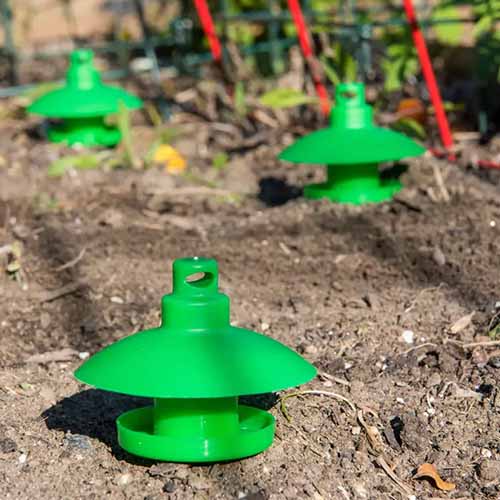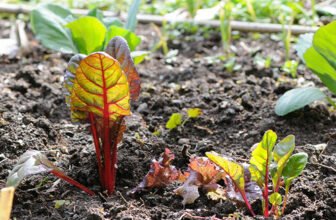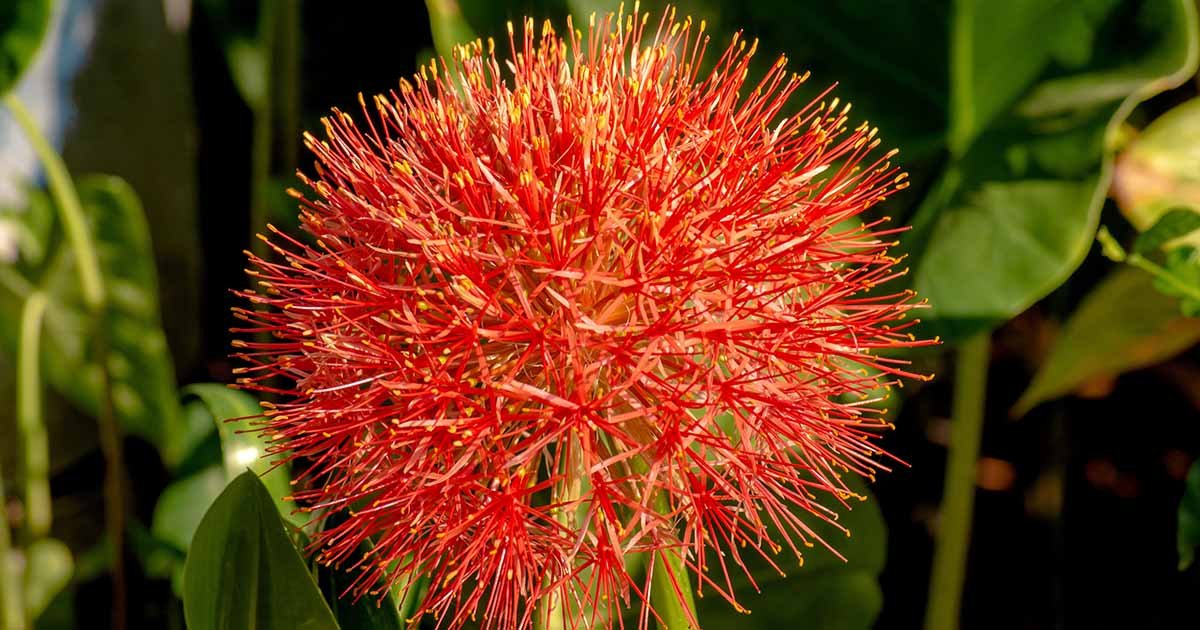
[ad_1]
Scadoxus multiflorus
If you’re a big fan of the puffy, globe-shaped blooms of ornamental alliums, then say hello to their crimson-blooming cousin: the blood lily.
The name “blood lily” might sound ironically hardcore for a flower, but since the fiery-hot hues of Scadoxus multiflorus blooms are blood-like, it’s actually a pretty accurate name.
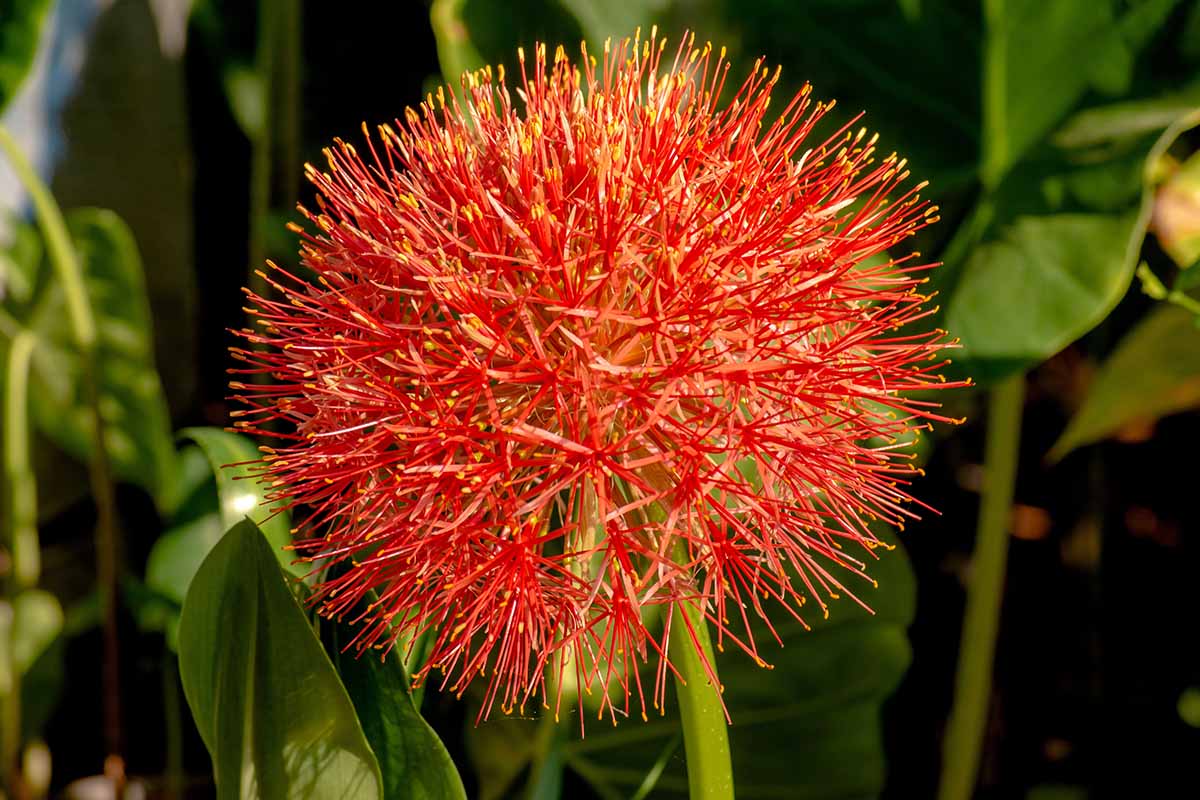

We link to vendors to help you find relevant products. If you buy from one of our links, we may earn a commission.
This crimson color pairs well with the light green hue of the leaves.
Combine these delightful colors with the striking floral shape, and you’ve got a really awesome plant on your hands. But how to grow it?
With knowledge, that’s how… and this guide has all the know-how you need to begin your plant parentage, from propagation to cultivation.
Here’s what we’ll be talking about:
What Are Blood Lilies?
Formerly classified as Haemanthus multiflorus, Scadoxus multiflorus is a bulbous perennial from the Amaryllidaceae, or amaryllis, family which includes snowdrops, daffodils, and amaryllis flowers.
Hardy in USDA Zones 9 to 11, the blood lily traces its origins to tropical Africa, parts of South Africa, and the Arabian Peninsula. Even though it has “lily” in the name, S. multiflorus isn’t a true lily plant of the Lilium genus.
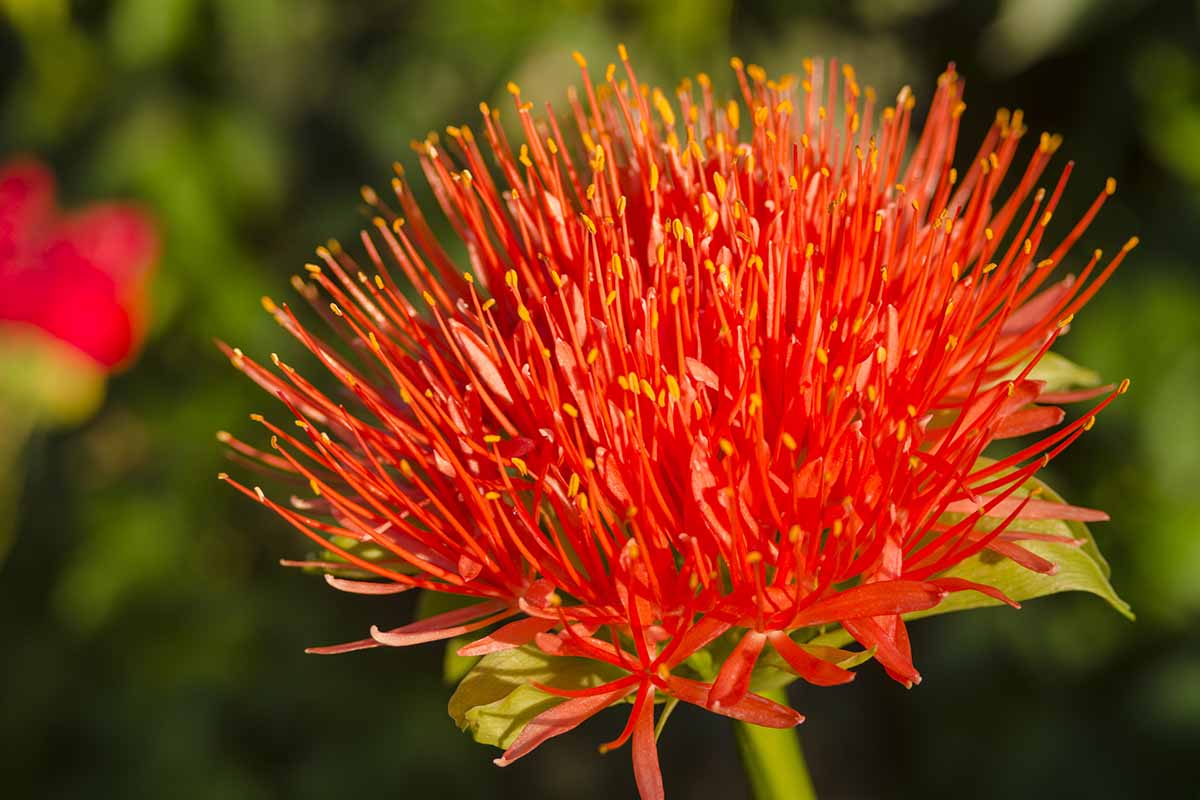

Let’s start with the bloom clusters: Red, spherical, and four to six inches in diameter, the flower heads are actually composed of many individual blooms borne on one to two inches of succulent stem, each with six pinkish-red petals and six yellow-tipped red stamens.
Blooming in summer, these flowers persist for up to two weeks. If pollinators do their thing, then orange to red berries will follow in fall.
The flowers and fruits don’t grow on actual stems, but rather pseudostems consisting of overlapping leaf sheaths that connect to a rhizomatous bulb.
From each red-streaked bulb grows six to seven bright green, lance-shaped leaves, each 12 to 15 inches long.
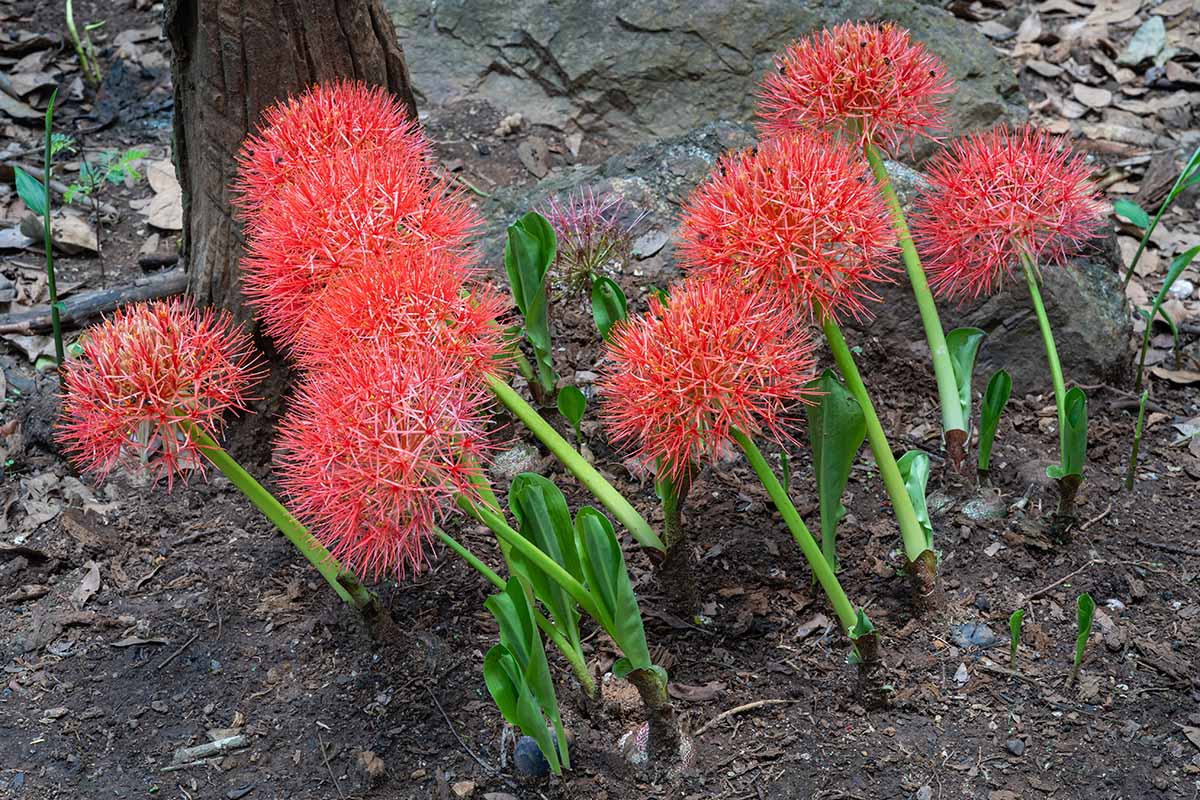

As a whole, each plant grows one to two feet tall and nine to 18 inches wide.
The bulbs contain toxic alkaloids, and should not be handled without gloves or consumed. This “no eating” rule goes for your pets and livestock, too!
There are three subspecies of S. multiflorus: multiflorus, katharinae, and longitubus.
The multiflorus subspecies is standard – hence the redundant name – while the katharinae subspecies has slightly larger dimensions and flowers. The longitubus subspecies has slightly elongated floral tubes, but it’s not commonly seen in cultivation.
Cultivation and History
The blood lily is more than just a pretty face – it has many practical applications.
Gambian farmers plant it as a good-luck juju for protecting their crops from thieves, Nigerian farmers mark the boundaries of their plots with it, and it’s used for poison fishing in both Guinea and Nigeria.
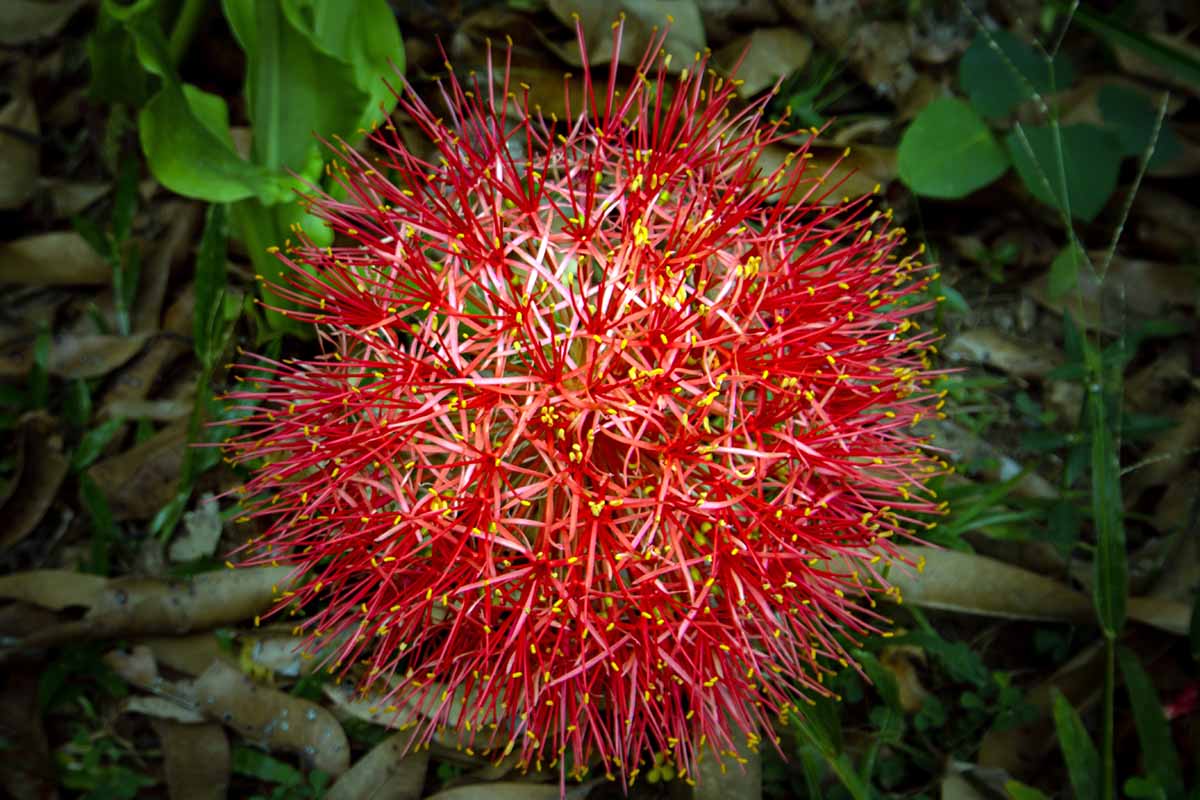

In many parts of Africa, S. multiflorus has a variety of medicinal uses. The crushed bulb is used to treat serious wounds and friction burns, while the dried bulb promotes lactation when rubbed on breast scarifications.
Blood lily ointment is used for ulcers, a decoction made from the crushed bulb is taken internally to treat hookworm, and the sap treats earache when applied directly into the ear canal.
I’m certainly not saying this stuff doesn’t work, but I am saying that you probably shouldn’t try any of it at home, as the plant is technically toxic to both humans and animals.
Consider this a surgeon general warning to proceed with caution… even though I’m neither a surgeon nor a general.
Blood Lily Propagation
To propagate blood lilies, you have four options: you can grow from seed, divide offsets, plant bulbs, or transplant a potted specimen.
From Seed
For seed sowing, you’ll need access to a specimen that has yielded fruit. Alternatively, you can snag some seeds from friends or a reputable vendor.
If you go the DIY harvesting route, wait until the orange to red berries either drop from the plant or are crinkled and ripe enough to fall at the slightest touch.
While wearing gloves, take the berries, mash them up, and remove the seeds within. Then, rinse the seeds in a strainer to remove all the pulp.
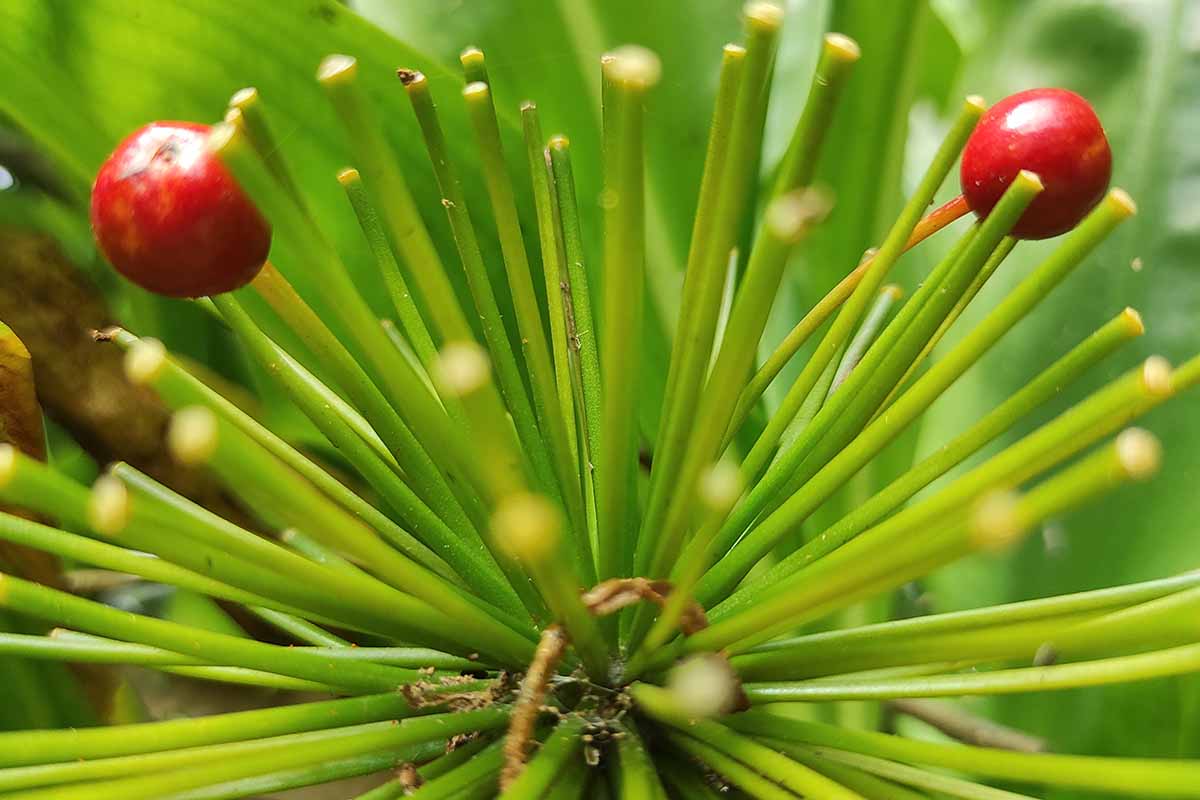

Fill a seed tray with a 50:50 mix of peat moss and perlite, and scatter the seeds on the surface of the growing media.
Gently press them into the media without burying them, then moisten with a spray bottle. Make sure the tray is exposed to bright, indirect light.
Keep the media moist as the seeds germinate. When new growth is observed which can take a few months, you can transplant them out in the garden or into individual containers.
It can take up to five years for a plant started from seed to bloom, so patience is key.
From Offsets
Blood lilies expand naturally by producing offsets from the mother bulb. Removing and replanting these every three to five years both manages a specimen’s size and provides you with more plants!
But first, it’s important to let your offsets develop for a growing season or two before expecting any flowers, since they probably won’t be large and developed enough to flower their first year.
In early spring, carefully lift your target plant, remove soil from around the bulb, and remove the offsets from the central bulb, either by using a sterilized blade or your gloved hands.
Return the mother bulb to its home, then plant each offset into its own container or patch of garden soil. Plant each offset bulb so that its “neck” is at the soil line, and water in the media around it.
Keep them well-watered as they become established which should take a few weeks to a couple of months.
From Bulbs/Transplanting
Whether you purchase new bulbs or are setting out ones you’ve lifted and stored over the winter months, planting bulbs is simple.
If you’re planting out in your landscape, make sure your intended sites are in full sun or part shade and have fertile, well-draining soil, with a pH of 5.5 to 6.5.
Potted bulbs should go in well-draining, yet moisture-retaining medium – an even mix of peat moss and perlite is perfect.
Ensure your chosen container has drainage holes in the bottom and is one or two inches larger than the bulb. You don’t want a container that’s too large as the extra potting medium can retain too much moisture and cause rot.
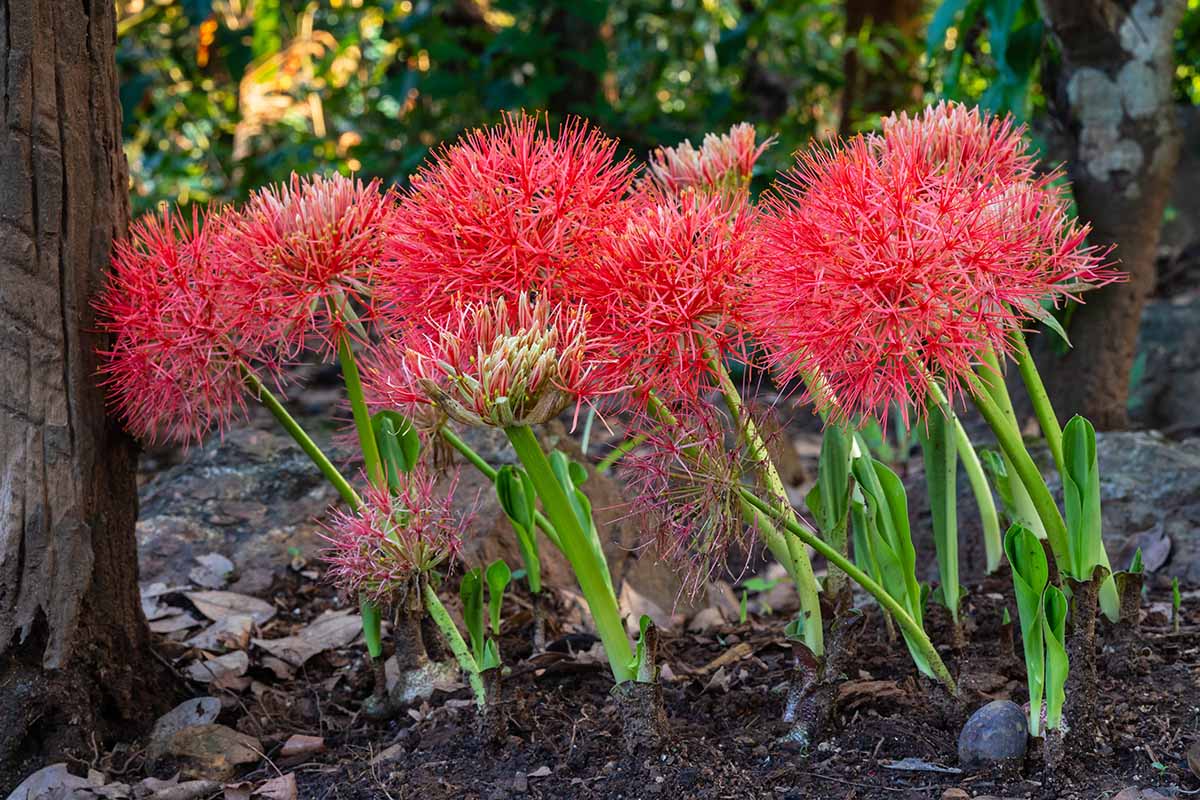

In spring, when all risk of frost has passed, plant each bulb an inch deep, apex up and basal plate down, spacing them nine to 18 inches apart.
Water in the soil around the bulbs, and keep it evenly moist as the bulbs grow and develop foliage.
If you’re transplanting a potted plant, dig a hole the same size as the container the plant is currently growing in, gently remove it from the pot, and set it in the hole. Backfill with soil and water in well.
Just be extra careful when you handle the root systems, as they don’t like being disturbed.
How to Grow Blood Lilies
Got some blood lilies planted? Let’s talk about how to keep them healthy and happy.
Climate and Exposure Needs
If you want to leave your bulbs in-ground year-round, then you’ll need to be in USDA Zones 9 to 11.
They can be grown in cooler climates, but they’ll need to be placed in containers that can be brought indoors before temperatures dip below 45°F. Any colder, and the foliage will turn brown and start to die back.
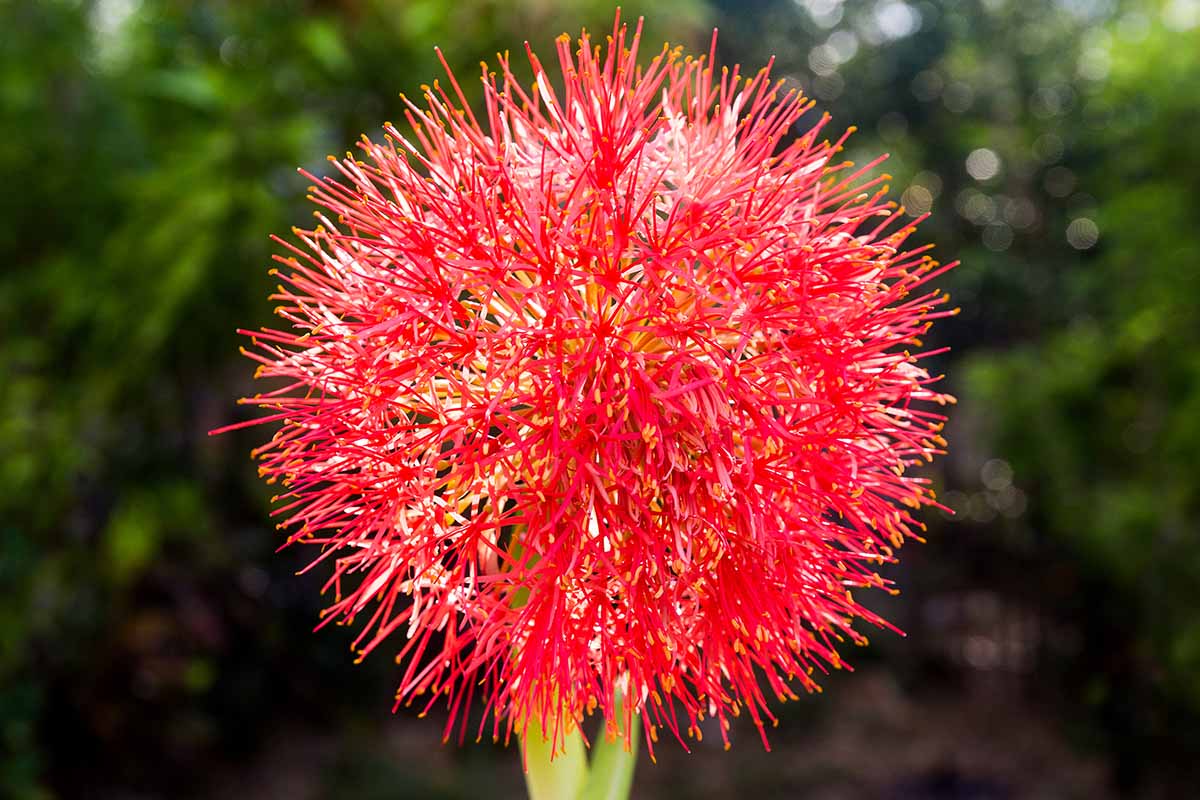

Choose a location in full sun to partial shade. The ideal spot would have full sun in the morning followed by some shade in the afternoon.
Bright, indirect light is best for plants that are grown indoors.
Soil Needs
The ideal soil for blood lilies is organically-rich, fertile, and well-draining, with a pH of 5.5 to 6.5.
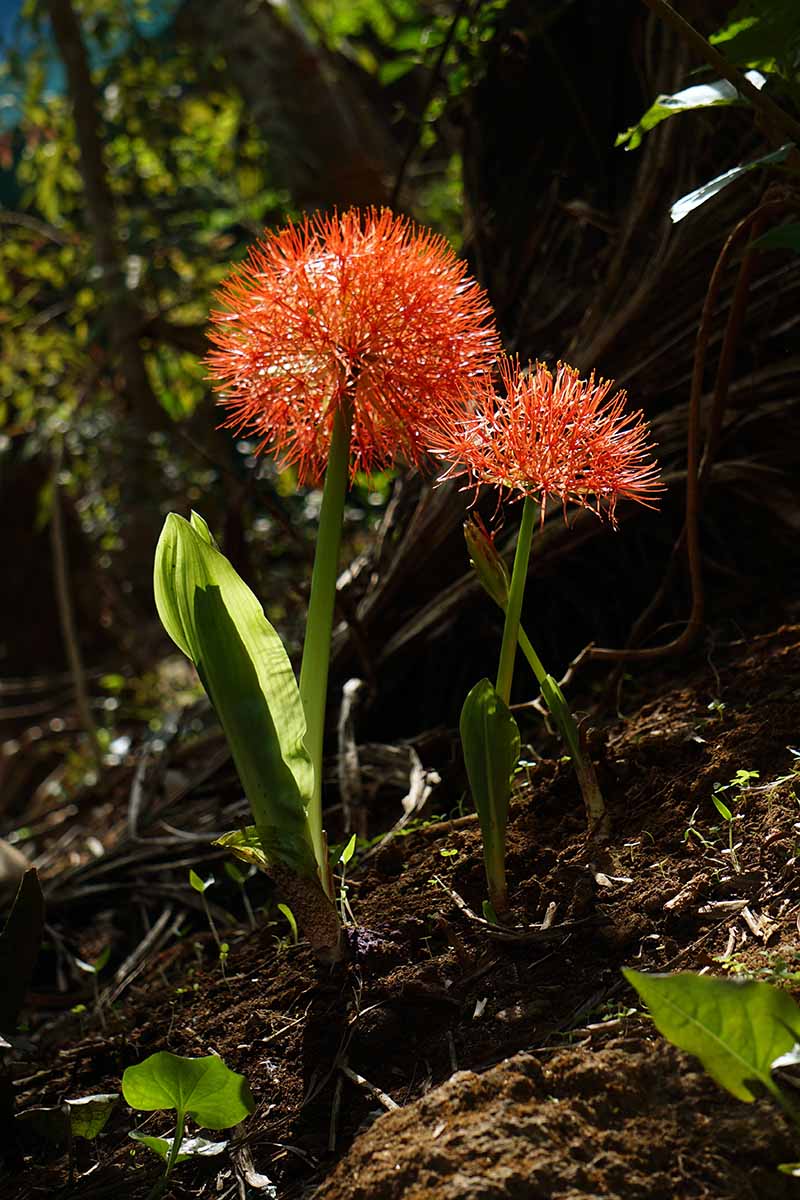

If your garden has particularly sandy soil, amend with compost or well-rotted manure to improve water retention. Clay soils can benefit from the addition of pea gravel as well as compost to improve drainage and add organic matter.
In spring, top dress with compost or well-rotted manure and carefully dig it into the soil around your blood lilies to add organic matter and nutrients.
Water and Fertilizer Needs
For optimal growth, maintain even moisture throughout the growing season. To do this, water whenever the surface of the soil dries out.
Stop any supplemental irrigation when the foliage dies back in fall.
Regular fertilization throughout the growing season, starting in early spring will help promote strong blooms.
A slow-release fertilizer only needs to be applied once or twice during the growing season, while a liquid fertilizer can be applied as frequently as every two weeks.
Jack’s Classic Blossom Booster
Try a phosphorus-heavy fertilizer like this 10-30-20 Blossom Booster from Jack’s Classic, available via Amazon.
Growing Tips
- Provide full to partial shade exposure.
- Water when the surface of the soil dries out.
- Fertilize regularly during the growing season.
Pruning and Maintenance
Blood lily blooms last for up to two weeks, so if you’re looking for cut flowers, that’s your window.
Be sure to cut the flower stem diagonally so it can still take up water while touching the bottom of the vase.
If you don’t want to collect the seeds seeds, cut the flower stems down to the ground when the blooms have faded.
When the leaves die, feel free to cut those to the ground as well to tidy up the garden. Remove any diseased or damaged plant tissue you happen to notice.


In Zone 9, in-ground bulbs benefit from a layer of mulch to help them survive the winter cold.
In cooler climates, the bulbs will need to be lifted and stored if you don’t want to plant new ones next spring.
When the foliage dies back in fall, lift the bulbs sometime before the first frost, once temperatures start to regularly stay below 45°F.
Cut the shoot and root tissue from the bulbs, and lay them out on newspaper for one to two weeks in a brightly lit indoor space so they can dry.
When they’re dry, put the bulbs in paper bags or in a cardboard box with ventilation holes, pack them with peat moss, and store them in a dark, dry place kept at 50 to 60°F until spring.
Where to Buy
To purchase blood lily bulbs, you could check with your local plant shops, bulb catalogs, or favorite online vendors.
You can barter for one at a plant swap, or perhaps snag one from a horticultural show.
If your fellow green thumbs have some bulbs or seeds to exchange for some of your own, then make with the trade!
You can find bulbs online available from Hirt’s Gardens via Walmart.
Managing Pests and Disease
Thankfully, S. multiflorus doesn’t really suffer from serious pests and diseases, and it’s even resistant to damaging herbivores such as deer, rabbits, and rodents.
But you’re not out of the woods yet. To keep your blood lilies entirely free of health issues, you’ll need to prepare for these potential problems.
Slugs and Snails
Whether they’re shell-less slugs or shell-wearing snails, these mollusks are real slimy, and real annoying.
With their uniquely-textured tongues, they eat leaf tissue like you or I file down our nails, which leaves uneven, yet smooth feeding holes in foliage. As a result, photosynthesis is hindered and the plant’s health is harmed.
Since these guys take shelter from the sun underneath the shade, it helps to remove any nonessential spots where they can hide: weeds, plant detritus, stones, etc.
If you notice slug and snail damage, you can go out at night with a flashlight to pick them off infested plants and crush or otherwise dispose of them.
You can also catch them passively with some slug and snail traps like these plastic green beer traps, sold in sets of three at Gardener’s Supply.
Our guide to managing slugs and snails can be found here.
Bulb Rot
Believe it or not, roots actually need to breathe a little – and when the soil around the root system is waterlogged, the roots don’t get the oxygen they need.
As a result, the root system and the bulb can turn necrotic and die, which hinders water and nutrient uptake for the rest of the plant, causing the foliage to turn brown and die back.
To prevent bulb rot in blood lilies, it’s essential to plant in well-draining soil and to avoid overwatering during the growing season. It’s also important to stop watering during dormancy.
If you’re growing your blood lily in a container, make sure it has adequate drainage holes.
And if bulb rot takes hold, you can try digging up the plant and moving it to a more suitable location or potting it up in well-draining potting mix. But if it doesn’t recover, you’ll have to pitch the rotted bulb.
Best Uses for Blood Lilies
A bright red ball of blooms can play many roles in a garden, it’s pretty enough to be the star of the show, while it can also support other specimens as an accent planting.
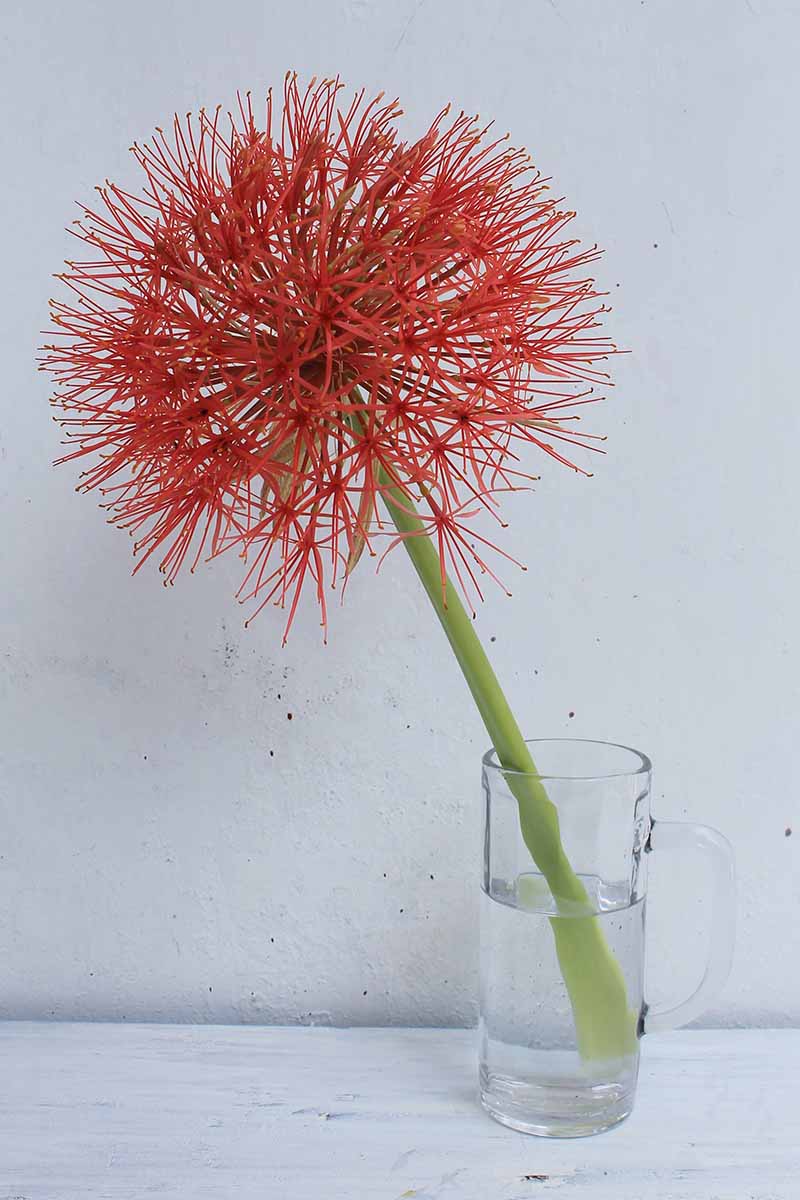

Put it in a container, and the blood lily is stunning on a patio or as an indoor houseplant. And don’t forget its power as a cut flower!
Quick Reference Growing Guide
| Plant Type: | Bulbous flowering perennial | Flower/Foliage Color: | Red/green |
| Native to: | Tropical Africa, Arabian peninsula | Maintenance: | Moderate |
| Hardiness (USDA Zone): | 9-11 | Tolerance: | Being root-bound, deer, rabbits, rodents |
| Bloom Time/Season: | Summer | Soil Type: | Rich, moderately moist |
| Exposure: | Full sun to partial shade | Soil pH: | 5.5-6.5 |
| Time to Maturity: | Within a year (from bulbs), up to 5 years (from seed) | Soil Drainage: | Well-draining |
| Spacing: | 9-18 inches | Attracts: | Bees, birds, butterflies |
| Planting Depth: | 1 inch | Uses: | Accent, cut flower, houseplant, container planting, specimen |
| Height: | 1-2 feet | Order: | Asparagales |
| Spread: | 9-18 inches | Family: | Amaryllidaceae |
| Water Needs: | Moderate | Genus: | Scadoxus |
| Common Pests and Diseases: | Slugs and snails; root rot | Species: | Multiflorus |
Don’t Be Silly, Snag Some Blood Lily
Trust me, growing blood lilies is well worth it. Blood-red blooms, a compact size, ease of care… what’s not to love?
Congrats on being able to grow this ball-shaped beauty. May it brighten your garden every summer!
Any questions, concerns, or tips and tricks of your own? The comments section is for you!
Are you interested in growing more plants with ball-shaped flowers? Have a read of these guides next:
[ad_2]




